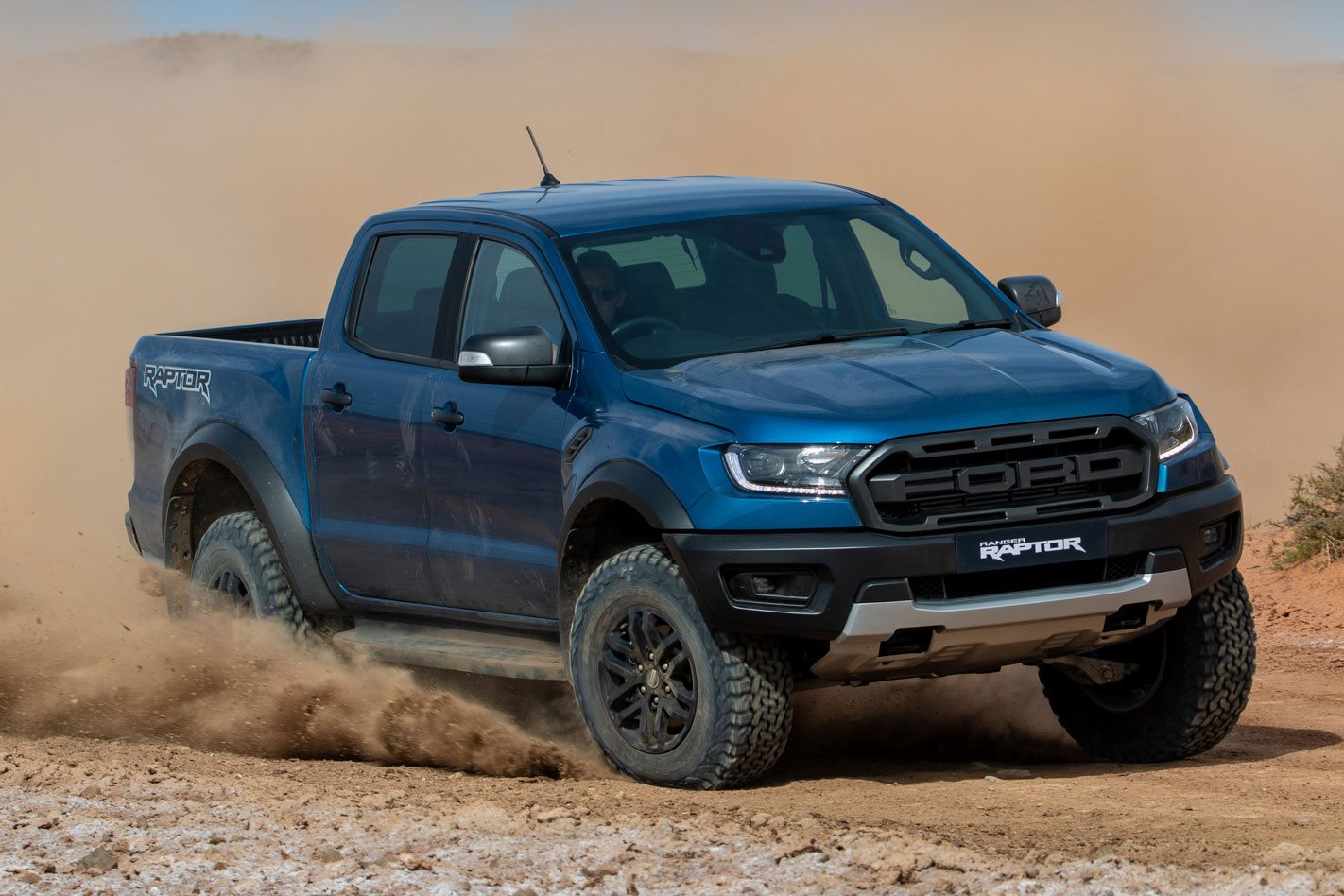AUTOMOTIVE powertrain engineers say ‘WOT’ quite frequently, not because they’re all a bit deaf, but because it’s techy, acronym-speak for ‘wide-open throttle’. You and I probably just call it ‘pinning the bastard to the boards’. Whatever the term, I’ve been doing it for a couple of minutes now and both revs and road speed have ceased to shift, so it’s safe to presume that this is V-max. At 4400rpm, the Ford Ranger Raptor’s 2.0-litre twin-turbo-diesel doesn’t sound uncouth, more an insistent, gravel-edged snarl. It feels like the automotive equivalent of the heart, lungs and legs of a decent middle-distance runner coming onto the stadium’s home straight; there’s harmony and robustness, mixed with a clear sense that this is all it has to give. Our speed? A GPS-corrected 173km/h.
A kerb weight of 2332kg and the aero slipperiness of a site office will do that. If we stay with the runner analogy, it’s like asking Mo Farah to hold the lid of a wheelie bin out in front of him for the final lap of the men’s 5000m. So yes, my top-speed run is just a bit pointless, but hey, the Raptor is built for speed, and I was compelled in the interests of science to see how it felt and sounded at top whack. Further, we are in the region of South Africa where plenty of car companies come to do their high-speed testing. It’d be rude not to, etc.
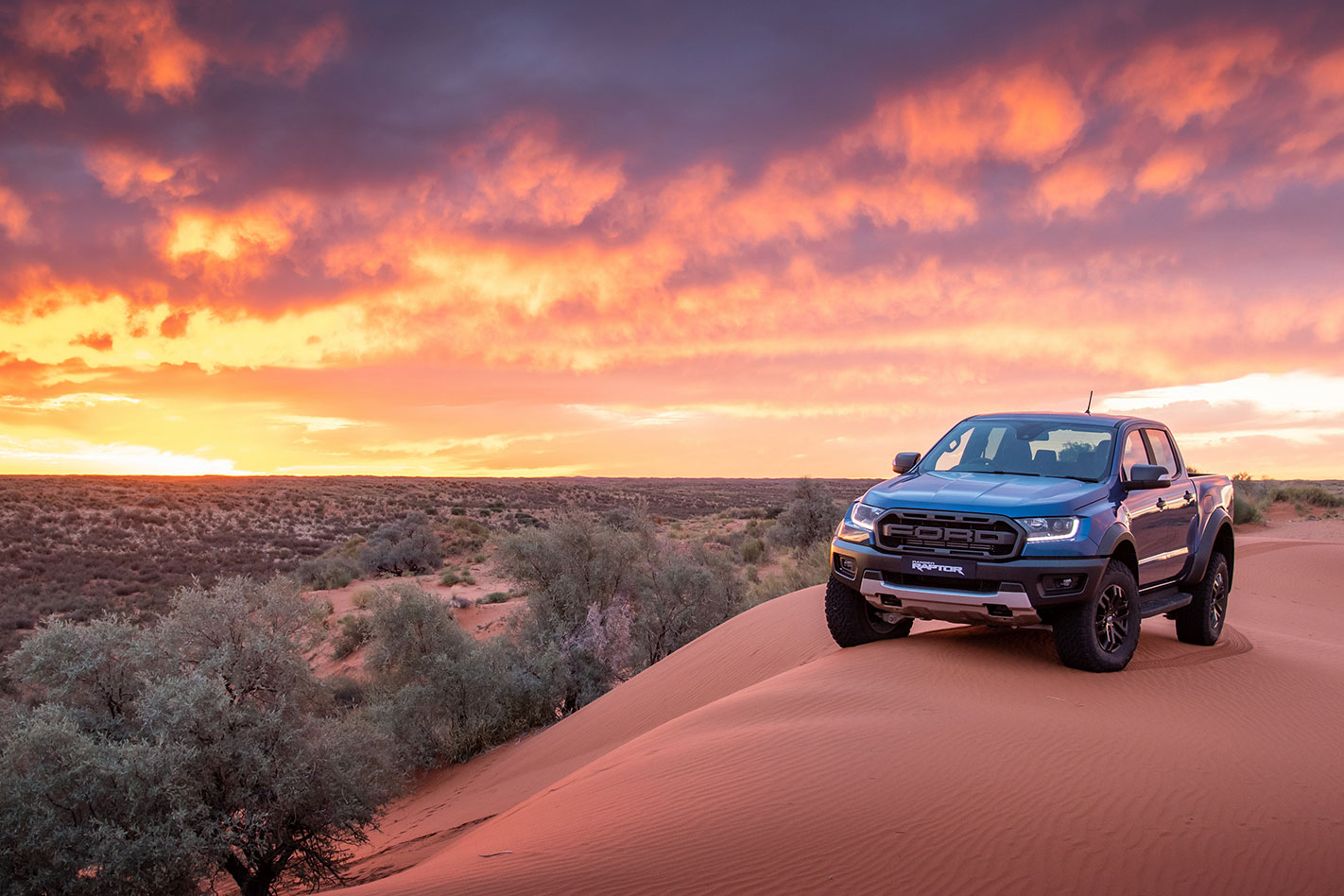
We’re 40km or so south of the town of Upington, a dusty backwater on the banks of the Orange River. Out here it feels every bit as remote and desolate as Australia’s interior. The sight lines are long, the blue-metal surface is good and vast stretches of wire fencing keeps animals clear of the roads. Oh, and the sparsely staffed police force – if they do in fact exist – apparently know to leave you alone, provided you have the correct number plates that indicate an approved prototype. Which we don’t, but two out of three ain’t bad.
But a V-max run is just a part of the transport stage to the main event: off-road race training with one of SA’s rising stars of the sport, 24-year-old Gareth Woolridge. This bloke made his international debut in last year’s Brazilian Rally dos Sertoes, runs up the pointy end of the South African Cross Country Series (SACCS), and reckons he can take me from lumbering middle-aged nuffie to lean, mean Finke Desert Rally material in just 10 hours.
Okay, he didn’t actually promise that, but a man needs to have ambition, and we do have at our disposal the most highly developed, off-road capable 4×4 ute on the market, as well as a punishing course through dunes fringing the Norokei salt lake.
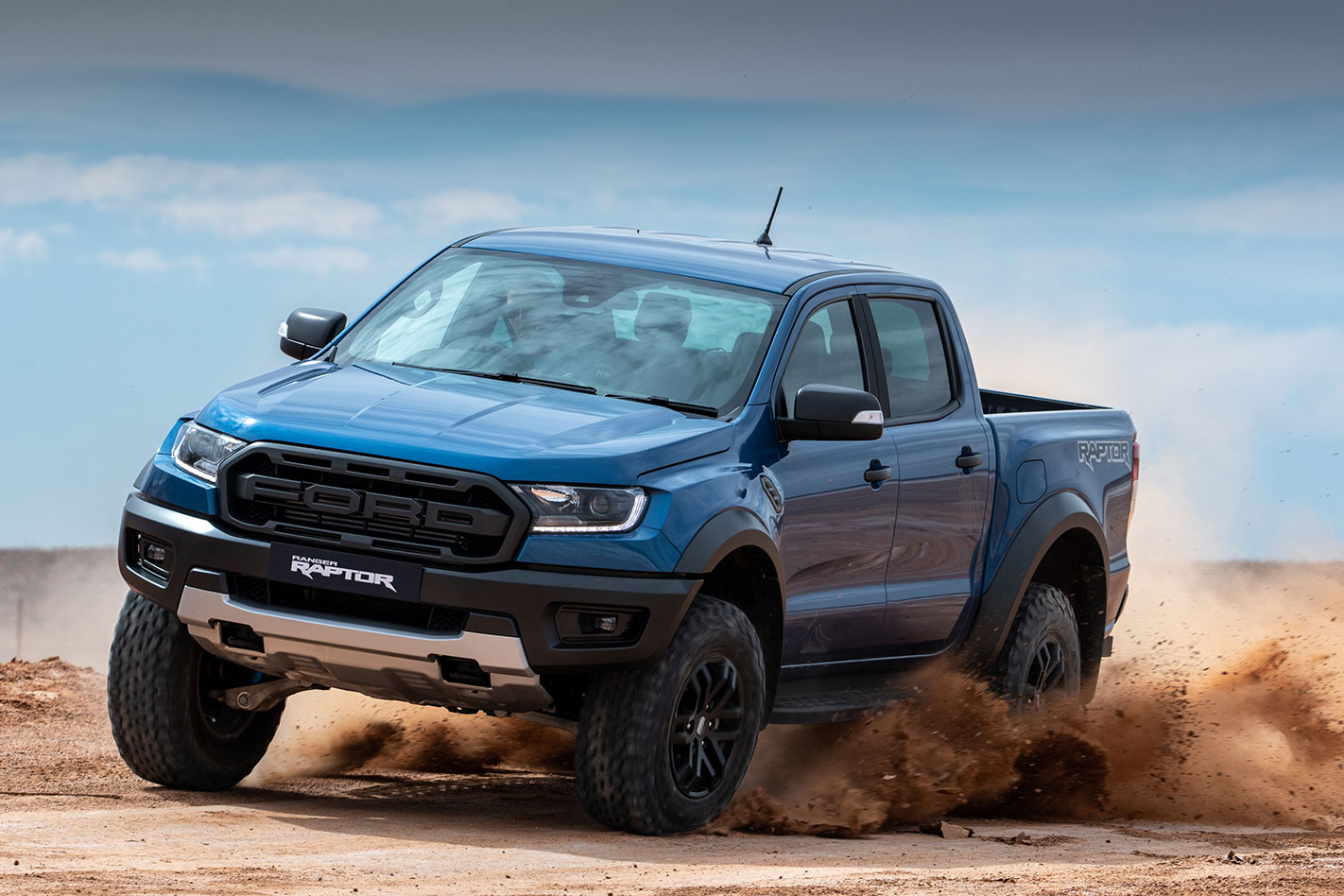
Nervous? A little, but Woolridge’s natural warmth and easy humour immediately helps, as does the fact he has a fit, but fairly normal-looking physique. He’s not one of those annoyingly whippet-lean circuit racers, who manage to make you feel fat and useless before you’ve even done up the belts.
“I train five or six days a week, but sure, I’m not scared of a few beers and boerewors [sausages],” he says with a laugh.
Wooldridge is part of an off-road-racing dynasty here in the land of the springbok. His dad Neil is a former gun racer and self-made 4×4 business owner turned constructor, employing a team of 20 to build Mustang V8-powered, tube-chassis Raptors for customer teams; while his older brother Lance is a reigning class champion in SACCS and in winning form again this year.
So the bloodline is strong, but job one right now for Woolridge is to get a read on what sort of student he has to work with. (Spoiler alert: ‘not gifted’.)
“Let’s do a sighting lap, then I want you to have a proper crack, and we’ll see where we can find some time,” he says.
Temps on the pan can reach 45 degrees in the peak of summer, but today is hazy and relatively mild at 26 degrees, meaning the diesel donk in the South African-built Raptor won’t have to deal with ingesting hot air. It’s no doubt happy about this, as am I, because, as Editor Inwood has found with his long-termer, and as will become evident during our sessions, there’s not exactly a surfeit of power going begging. To recap, it makes 157kW and 500Nm. Yes, today there will be plenty of WOT.
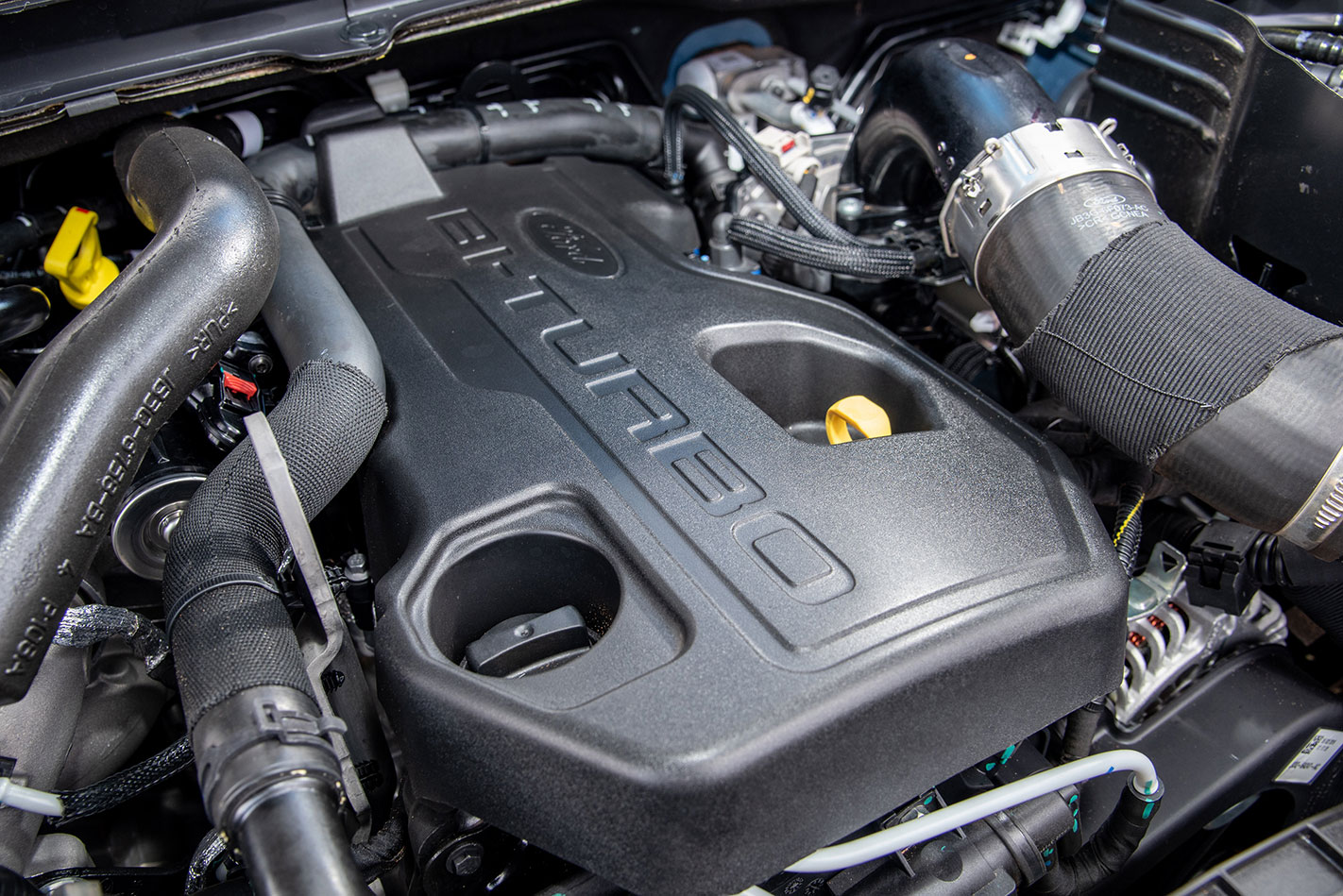
Starting now. There’s nothing too complicated about the course – the fast, flat section snaking across the dry-lake ‘pan’ is clearly marked with flags at the apexes, then the climb and plunging descent of the dunes is very much single-trail, but punctuated by deep wallows, wash-aways, rock gardens and plenty of stout vegetation to hit if you go off line.
So I select Baja mode, which allows ample oversteer angle if the sensors figure you’re in control, and get my WOT on. Yes, more vigorous acceleration would be welcome, and this leads to my first rookie error. I dumbly apply a circuit-lapper’s technique of trying to minimise lost momentum and carry maximum apex speed, but this is costing me in terms of forcing a wider – okay, messier – line. “Brake harder for the tighter sections and get it turned in; keep your line tighter,” Woolridge instructs. “Don’t concentrate on apex speed. In the fast turns, you’re going well; keep flicking it very early – even earlier than you’re doing – and keep your foot deep into it to hold the slide. That’s where the momentum of the slide will make you quicker than trying to keep it straight.”
I get that bit, and I’ve never met a bit of extended oversteer on dirt that I didn’t like, so things are going fairly well on the flat. But up in the dunes I’m initially too conservative, and underestimate just how much punishment the Raptor’s chassis can absorb. Mentally, I’m in “don’t wreck the vehicle” mode, when I should actually be in the “try and kill the bastard” zone.
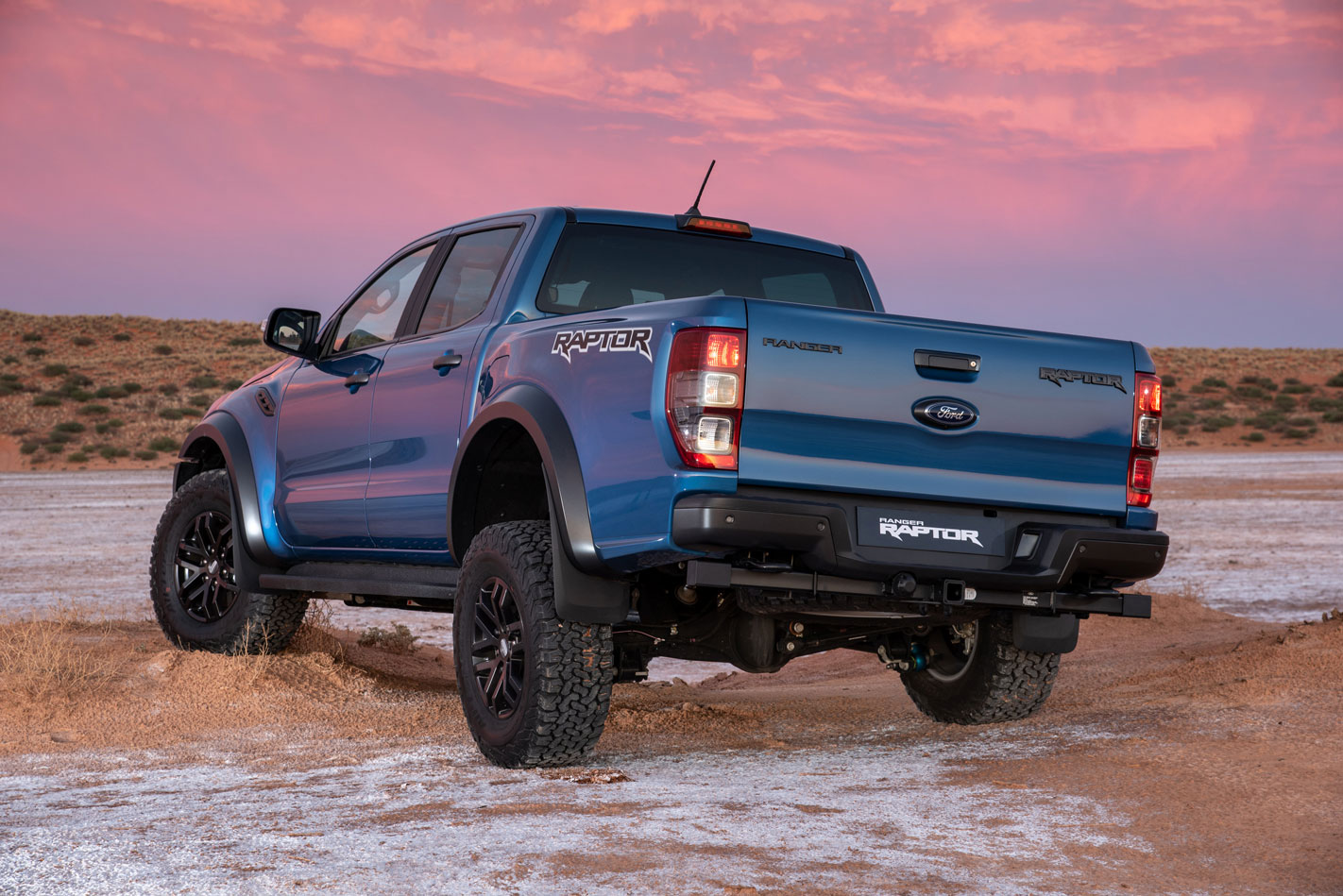
The widening of Raptor’s track (by 150mm), the Watts-linkage rear end (replacing leaf springs), and, crucially, the move to the Fox remote-reservoir dampers that bring extra wheel travel and ground clearance, all combine to make this thing a proper masochistic beast over terrain that would cripple a regular 4×4 ute. It’s not just the ability to mercilessly belt the front end at big speed into deep washaways, it’s the rebound control that demands you recalibrate what’s possible. Even if a standard-sprung ute could handle the compression impact, its rebound rate would likely pogo you into the next postcode.
Not here. Calls of, “Good! Good! Stay planted! Keep the momentum! No brakes needed here!” will be the over-arching theme from the passenger’s seat, and even for a slow learner like me, it’s an easy directive to follow. At least until I barrel too hot into a fast left-hand kink, exactly where the track transitions from hard-packed gravel to rock. I can’t quite get turn-in grip and go straight-on under brakes, mowing down a quarter-acre block of scrubby vegetation and damaging a tyre sidewall on a rock edge. “Not a problem, that lot needed clearing,” deadpans my instructor as we limp back for a fresh rear hoop.
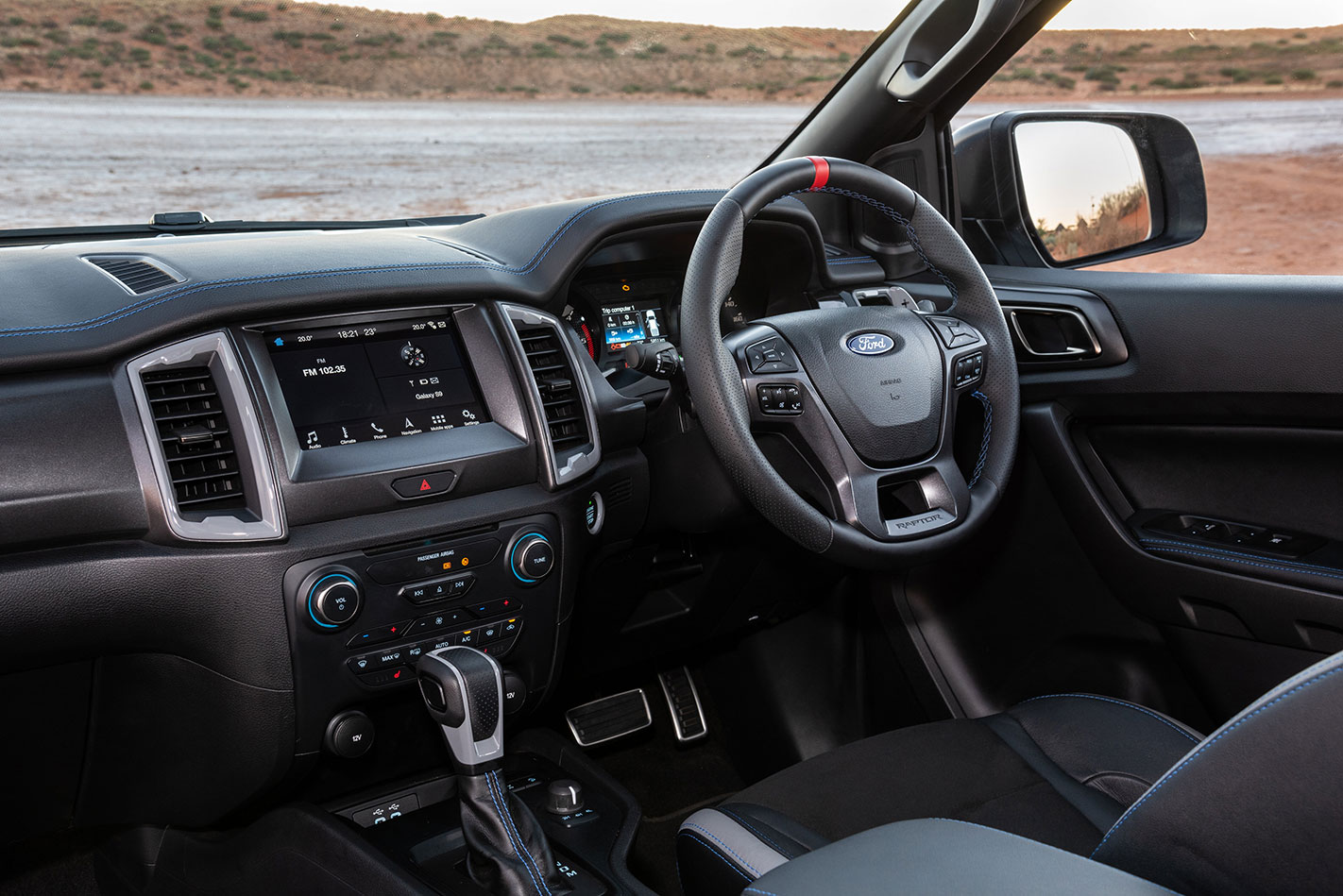
Woolridge makes light of my ‘moment’ but it’s a reminder, in case I needed one, that off-road racing can be every bit as treacherous as rallying or circuit racing (well, on anything other than a Hermann Tilke-designed track). Since the Paris Dakar Rally Raid was first run in 1979, there have been 26 competitor fatalities from accidents. Okay, 19 were motorcycle riders, but that still leaves six that were car-related (plus one truck), proof that off-road racing’s comparatively slower speeds won’t alone save you, if the remaining circumstances conspire the other way. By comparison, our own Finke Desert Race has had three fatalities since it started in 1976.
“I count myself as pretty fortunate,” says Woolridge. “Of course I’ve had some pretty substantial offs, but nothing that’s seriously injured me…” He’s clearly reluctant to be drawn further into this morose conversational cul de sac, so we quickly move onto a brighter subject: the fact that if I was a boxer, I would have the hand speed of Eric ‘Butterbean’ Esch, when I need to be more like Manny Pacquiao. As we barrel along a section of the dunes stage, the trail jinks constantly and the Raptor requires a constant flurry of steering inputs to carry our speed. It turns out that my default technique of striving for smoothness has no real place in the frenetic world of off-road racing. “I want you to be like lightning on that wheel!” yells Woolridge over the noise of the engine, low scrub hitting the sills, and the audible puckering of my sphincter. “Faster hand speed! C’mon!”
He says it as “forster”, which I really shouldn’t be registering, given how much is going on: a crazy torrent of twists and kinks rushing at us through the screen, the suspension working at maximum effort to absorb the bombardment of ruts and trenches, our skulls and torsos shaking around like oversized Bobblehead dolls.
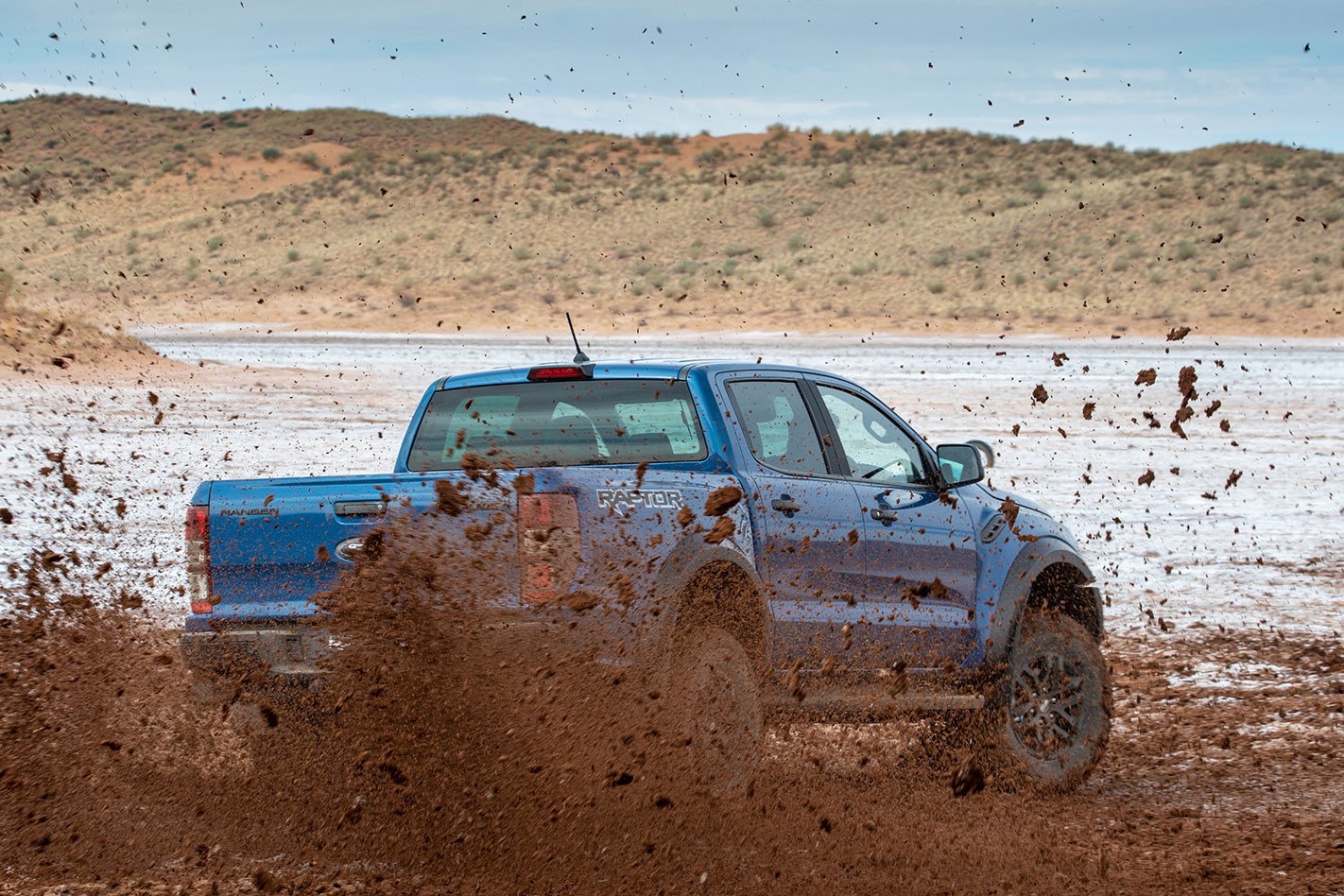
Perhaps subconsciously I hadn’t been fast enough with steering inputs for fear that the rack assistance wouldn’t keep up, but this, like many things I imagine, proves to be utterly unfounded. I go into full “angry fighter on the speedbag” mode, and this meets with approval from my co-pilot. He’s right, of course – really going next level on the speed at which you work the wheel seems to get the big Raptor almost dancing between the kinks, and your right foot quickly falls in line, a WOT-ease-WOT quickstep that’s hugely satisfying. Throw in a bit of ‘berm surfing’ on the sandy, favourably cambered corners, and I could be a convert to this off-road caper.
But before I book my entry for the 2020 Finke, there’s another discipline I need to master.
Anyone who’s watched any off-road racing knows that in fast, whoop-filled territory, the cars often seem to spend as much time airborne as they do on the deck. So, time to get my flight wings.
Helpfully, Ford has found a quiet backroad nearby that’s perfect for the task, and the local farm owners have agreed for it to be closed off. It’s just a few kilometres long, but punctuated by six successive, super-steep ‘kickers’ that climb at around 18 percent gradient in the space of just a handful of metres, before dropping sharply over the other side. Even more thoughtfully, each has been hand-signposted with an advisory speed that is sufficient to – just – get a Raptor’s wheels clear of the ground.
We quickly agree I’ll need to add at least 20 percent to get anything that qualifies as air time, but I also need to focus on my throttle technique, advises my unflappable co-pilot. There was me thinking it was just a case of boshing the brave pills, whipping up some speed, and not squealing like a girl when you force a 2.3-tonne ute into airspace it really shouldn’t be in.
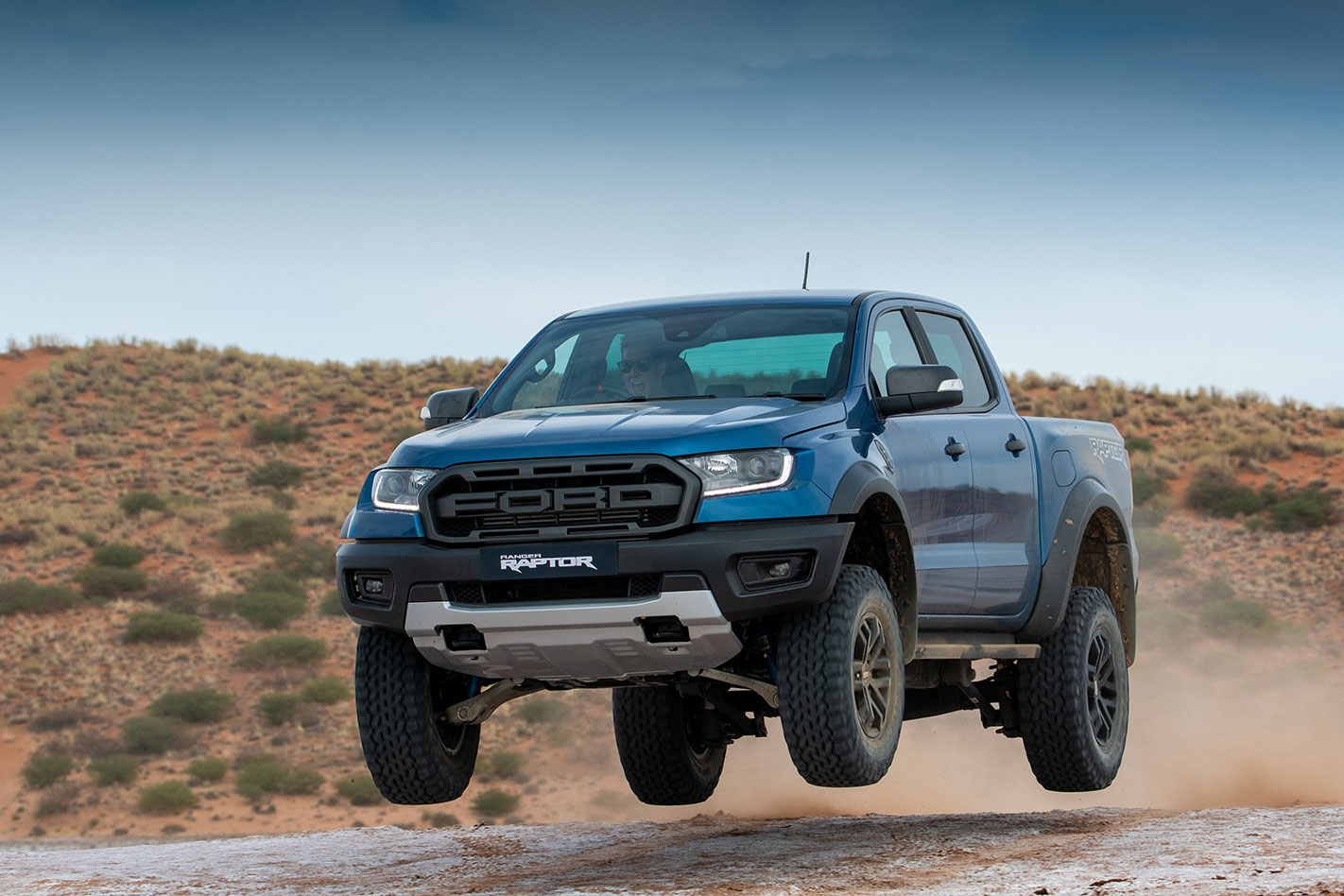
Turns out there’s more to it than that. “Carry plenty of throttle right up to the lip of the crest, because that will determine our trajectory,” Woolridge explains. “If you chop the throttle at the last moment, it’ll make the nose drop even more than it would because of the [forward-biased] weight distribution.”
In simple speak? “Man up and keep it pinned.”
We fly like a large box-section ski jumper, and land much better than Eddy the Eagle used to. My brain is calibrated to expect a landing from this speed and height to be like something from the San Francisco street scenes in Bullitt, but of course it’s nothing like that; more like dropping a cold chisel onto a feather pillow. The chassis of this thing really is exceptional, and today has proved conclusively it deserves an engine that can fully exploit what the underpinnings offer.
Right now, Ford’s response remains a cloth-eared, “WOT?”, but as the groundswell builds for this excellent chassis to have a more potent powerplant, expect that to change.
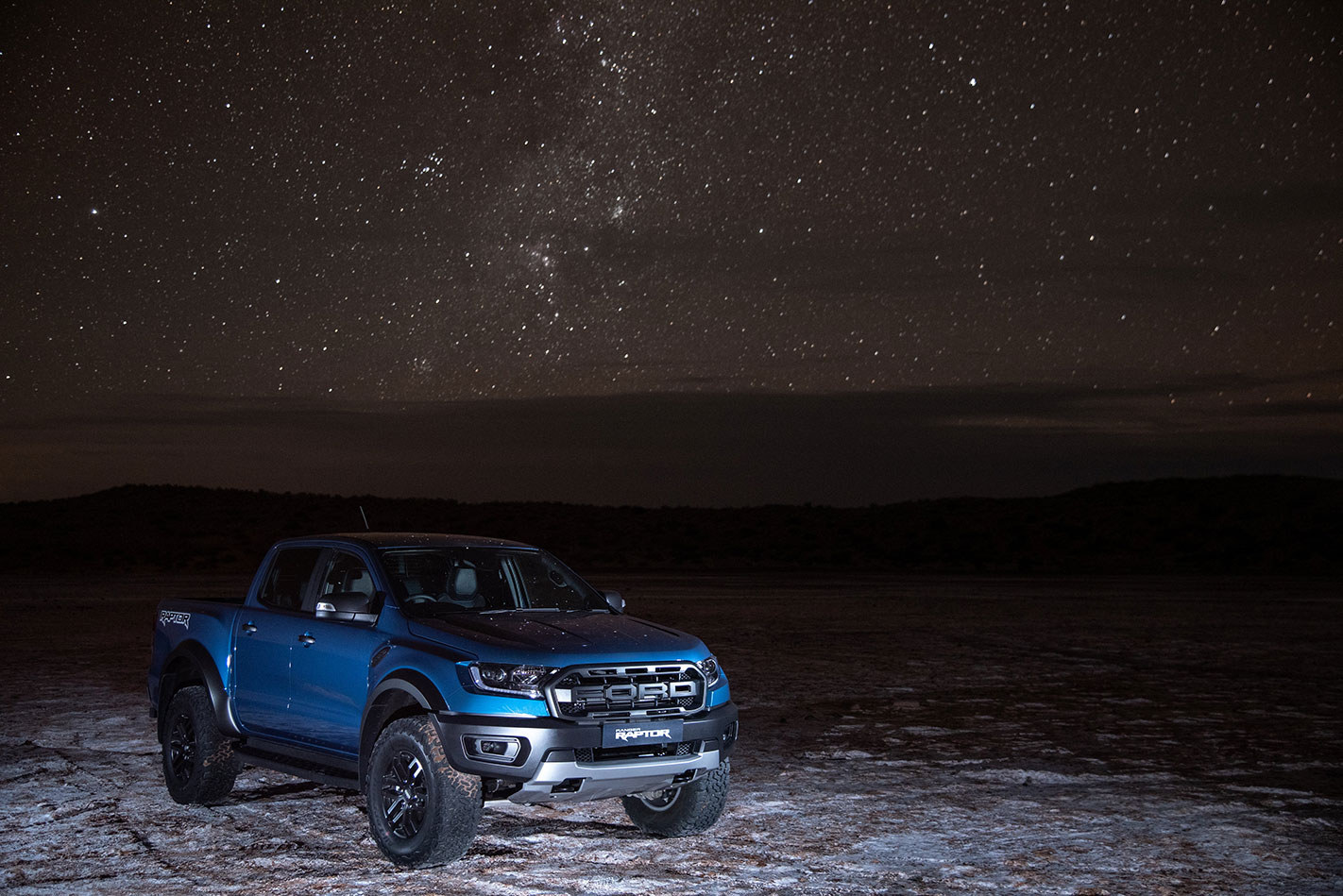
Ford Ranger Raptor Price & Specs
Model: Ford Ranger Raptor Engine: 1996cc 4cyl, dohc, TTD Max power: 157kW @ 3750rpm Max torque: 500Nm @ 2000rpm Transmission: 10-speed automatic Weight: 2332kg 0-100km/h 10.5sec (claimed) Economy: 8.2L/100km Price: $74,990


